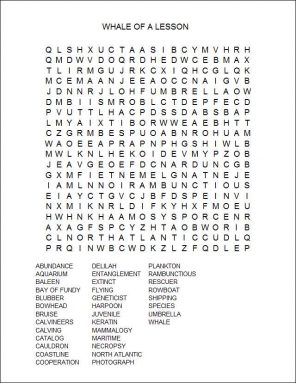Whale of a lesson
Once given up as all but extinct, the North Atlantic right whale is making a comeback
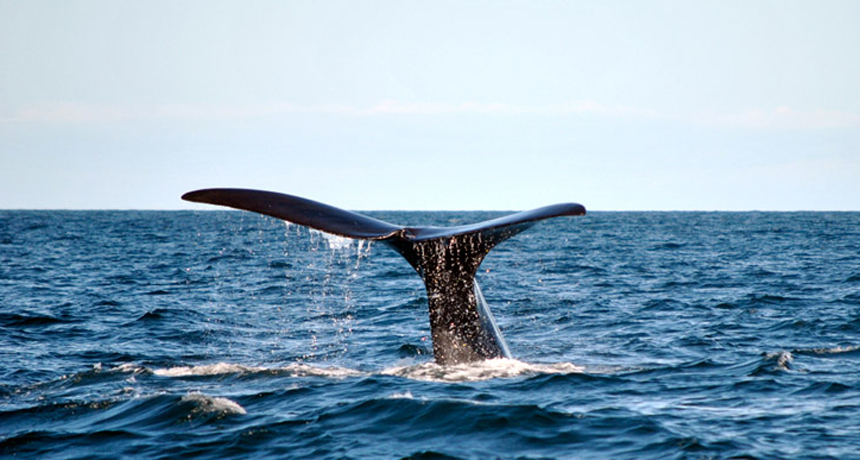
A North Atlantic right whale lifts its tail to dive in the Bay of Fundy.
Eric Wagner
By Eric Wagner
Late in the summer of 1992, Scott Kraus and Moira Brown were in Canada, eating pizza with some coworkers. Suddenly, the restaurant’s owner came into the dining room and asked: “Is there a Scott Kraus? There’s a phone call for you.”
Kraus was confused. They were in southern Nova Scotia, about 150 kilometers (93 miles) southeast of Maine. It was practically the middle of nowhere, he thought. Who could possibly know he was there, and what could be so important?
After taking the call, he returned with terrible news. A dead right whale had been seen near Grand Manan Island, on the western side of the Bay of Fundy. This is near the border between Maine and Canada.
Kraus and Brown are biologists with the New England Aquarium in Boston. They study the North Atlantic right whale, one of the world’s rarest species. Some cruise along the coastlines of North America; others live off of Europe. Together, their numbers totaled fewer than 350 in 1992, so losing even one was troubling. (Right whales also live in the North Pacific and in the Southern Hemisphere, but those are different species.)
The next morning, the scientists set sail to view the whale, hoping they could figure out how it died. As her carcass came into view, they sadly recognized that they knew this whale. It was one they had earlier named Delilah.
She didn’t have a mark on her, but a necropsy (the animal equivalent of an autopsy) would later find a massive bruise all along her body. It appeared the 13-meter-long (about 42-foot) animal had been accidentally hit by one of the ships that regularly sail through the Bay of Fundy. The biggest ones can be as tall as 10-story buildings, span more than 300 meters (about 1,000 feet) and weigh tens of thousands of tons. These ships cruise much faster than a 37-metric-ton right whale can swim.
Even if a captain saw a right whale in his path, it could take a half hour to bring the ship to a stop. Delilah never stood a chance.
Later that day, Brown and Kraus talked to others who had seen the dead whale. One storekeeper brought out pictures he had taken. The biologists could make out a small calf in the photos. It had been swimming beside Delilah’s body.
Brown’s heart sank. Right whale calves typically stay with their moms for about a year, nursing on warm, rich milk. This calf was only about 8 months old.
Brown and Kraus were joined by other members of their research team, who were stationed nearby in Lubec, Maine. The biologists split into two teams. One stayed to examine the dead whale. The other went in search of her calf.
The researchers spent two days looking for the missing calf. But they saw no sign of it. Eventually, they called off the hunt, certain it must have starved.
But the next summer, other whale-watching scientists spied a juvenile right whale off of Nova Scotia. They sent photos of it to Brown. Astonished, she recognized it as Delilah’s calf. Somehow, the little whale had survived.
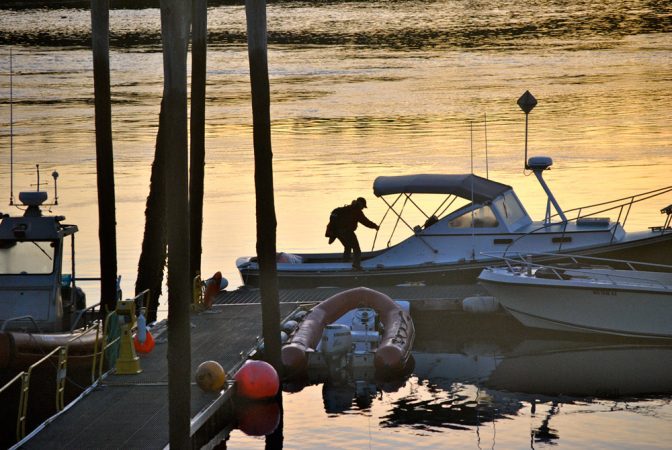
Brown was so delighted that she decided to name the juvenile Calvin, after the tough, rambunctious little kid in the comic strip Calvin and Hobbes. And looking back now, she says, it’s not hard to think that the plucky little whale’s tale can give scientists hope for how its species will fare in the near future.
The right name for the whale
Many whales are named for some characteristic trait. The humpback whale, for instance, has a hump on its back. The blue whale’s skin is bluish. And the right whale? That’s the species American whalers in the 1800s considered the “right whale” to hunt.
Among their reasons: Right whales were such slow swimmers that even men in a rowboat could catch them. And the animals had so much thick fat, called blubber, that once harpooned, their carcasses would float like logs. (Most dead whales sink.) When boiled with the bones of whales in large cauldrons, that blubber gave up huge quantities of useful oil.
Today people rely on petroleum, brought up from deep underground, as a primary source of oil. But back in the 1800s, people used whale oil for everything from lighting street lamps to lubricating machines.
Also valuable were the long plates of baleen that hang down from the inside of a right whale’s upper lip. These structures filter food from seawater. A single whale can have more than 200 baleen plates, each hung down nearly two meters — about as long as a door is tall!
Right whales, which can grow more than 16 meters (55 feet) long and weigh 63 metric tons. Their baleen plates can filter billions of rice-sized plankton from the water in a single feeding session. Mark Baumgartner, a biologist at the Woods Hole Oceanographic Institution (WHOI) in Massachusetts, likes to note that right whales are roughly 50 billion times as massive as their prey. That is one of the largest predator-prey differences in the world.
Baleen is made from keratin, just as your fingernails are. But baleen is much thicker and stronger. More than a century ago, people made corsets, umbrellas and venetian blinds from baleen.
Because a whale’s oil and baleen were so useful and valuable, people hunted the gentle giants for centuries. By the time this practice was outlawed in 1935, only a few dozen North Atlantic right whales still existed.
Brown says no one spent much time trying to save them after the species first received protection. Why bother? Most reasoned the species would probably go extinct anyway. Then, in the 1960s, two Woods Hole biologists spied a group of right whales near Cape Cod, Mass. It was the first time scientists had spotted the species there in decades.
For the next 10 years, the more that scientists looked for right whales off of the Massachusetts coast, the more whales they found. Then, in 1980, Scott Kraus was flying over the Bay of Fundy, surveying marine mammals, when he spotted a small group of right whales. Thrilled, he flew repeatedly over the bay during the next few days. In all, he counted 25 right whales.
But what excited him most was that four had been females with calves. Until then, no one had realized the bay’s importance: It served as a whale nursery.
Calvin reappears
Over the years, biologists at the New England Aquarium have put together a huge catalog that includes photos or details of nearly every North Atlantic right whale in the western North Atlantic. Whenever a biologist spots one of these animals, they photograph it and record its distinguishing features for the catalog. The descriptive information may list scars on a whale’s back or tail. But mostly, the catalog focuses on an animal’s head.
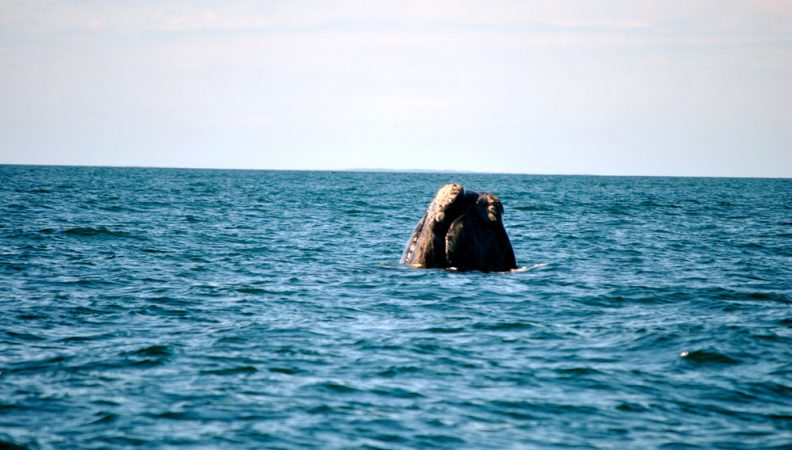
Right whales have raised patches of tough skin, called callosities, all around their mouth and blowhole. Each whale’s callosities form a unique pattern — as unique as the pattern of freckles on someone’s face.
Biologists use this catalog to identify whales each time they are seen. Information like where a whale appeared and what other whales it hung out with help U.S. and Canadian scientists figure out how the whales are related to one another.
It was through a photo in this catalog that Brown recognized Calvin in 1993. But the picture supplied only a little information. The next year, Brown learned much more. Calvin, already longer than a school bus, was getting closer to adult size. When Brown had a chance to get close to the whale, she shot a special kind of arrow into the animal. A hole in the arrow collected a small piece of skin — a sample about the size of a pencil eraser.
Later, back in a lab, she analyzed cells in that sample. They showed Calvin was a girl! And this female turned up again and again, over the years, as she made an annual migration along the East Coast of North America.
Western members of Calvin’s species migrate about 3,000 miles (4,828 kilometers) roundtrip each year between Canada’s Bay of Fundy and the southeastern United States. Each leg of the trip can take a month or more.
Sometimes biologists spied Calvin in Cape Cod Bay; other times, in Canadian waters. Then, in December 1999, she turned up off of the coast of Florida.
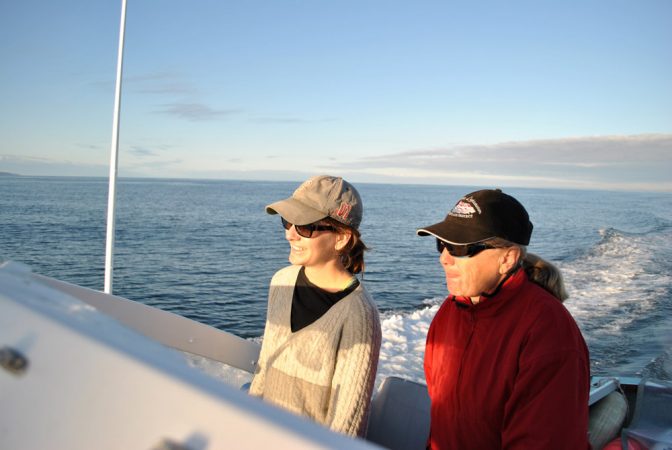
“We were thrilled,” says Brown. The Florida location was a calving site for right whales, and Calvin was nearing the age when females first give birth.
Calvin gets caught
But when Calvin was seen in the Bay of Fundy the following August, she was alone. Especially troubling, fishing lines encircled her body, cutting into her back and tail.
A few months later, when Calvin was next seen in Cape Cod, she was still entangled. Trained rescuers raced out to cut the fishing lines. They approached carefully. A scared animal that’s as long as a school bus and several times as heavy is dangerous — especially when she doesn’t understand what these humans plan to do.
Whenever Calvin surfaced to breathe, the rescuers zipped in, using a small boat. As she came within reach of the long poles they carried, they tried to cut the fishing line. But Calvin gave them only a few chances to cut the gear before diving deep and vanishing.
Those rescuers had managed to attach a buoy to the gear wrapped around Calvin, along with a device that would let them track her. Afterward, they followed her progress from afar, on computers. When the tracker stopped working, they hoped that meant the gear had fallen off. Sure enough, when they saw Calvin a few months later, the fishing lines were gone.
But she carried a reminder: permanent white scars on her skin.
Amy Knowlton, a biologist with the New England Aquarium, has studied whale entanglements for more than 10 years. At least eight in every 10 right whales become entangled in fishing lines at some point in their lives, her findings indicate. More than half of those will get caught more than once. One whale Knowlton studied became entangled seven times.
Some whales never free themselves from such fishing lines, nets or roping. If cuts from the entanglements become infected, a whale can sicken — even die. Or if something snags this gear while a whale is underwater, the animal can drown.
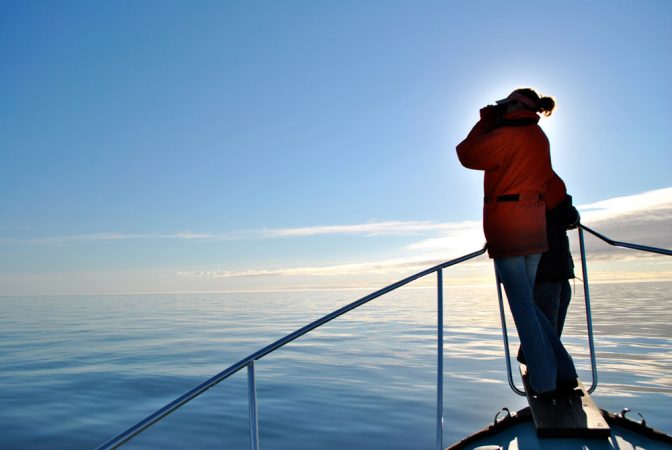
One study found that fishing gear killed or seriously injured more than 1,500 whales in the North Atlantic between 1970 and 2009. These included right whales and seven other species.
Whale entanglements are clearly a problem, Knowlton says. And they appear to be on the rise. Limiting the risk will require cooperation between scientists and the fishing industry. Fishing fleets don’t want to hurt whales, Knowlton says. “It’s a question of finding a solution that will work for both whales and people.”
Calvin becomes a mom
After she was freed from the fishing lines, Calvin periodically showed up in whale-spotters’ records over the next few years. But no one saw her in the Bay of Fundy. Brown worried that this whale’s run-in with fishing gear meant she wouldn’t breed. And breeding females are the most important right whales — without them, there would be no new right whales!
Then, on December 30, 2004, Calvin was spotted moving north along the southeastern U.S. coast. This time, she wasn’t alone. Beside her was a new calf.
A few months later, the pair entered the Bay of Fundy, where Calvin’s own mother had brought her 13 years earlier. “It was like a full circle,” Brown says. “But she arrived in a very different Bay of Fundy than her mom did.” For one thing, there were fewer boats crossing right whales’ paths in 2005 than in 1992. There also were more right whales in 2005 — almost 500.
Brown and her crew saw Calvin and the calf several times that summer as mom fattened up on the nourishing plankton and the calf on her milk. The scientists named the calf Hobbes and took plenty of pictures of the young animal. Come fall, mother and calf headed south again.
Calvin is more than 20 years old now. She had another calf in 2008, and was last seen in April 2012 off of the Massachusetts coast. If all goes well, Calvin might live another 50 years and give birth to more calves.
“She’s such a success story,” Brown says. “Here was this whale that wasn’t supposed to live, but she did. Now she’s contributing to the population, helping it grow. She’s just terrific.”
How rare are right whales today?
There used to be more North Atlantic right whales centuries ago. No one knows how much the current population must grow before scientists will consider its size healthy. Biologists had assumed that at some point in the past, many thousands of these animals had roamed the Atlantic and that whaling had killed off most of them.
Now they’re not so sure.
In 1978, archaeologists found old whaling stations in eastern Canada that dated from the early 1500s. Hundreds of bones were at the stations, testifying to many years of whaling.
More than 20 years later, geneticists used those bones as a source of DNA. Geneticists can study segments of DNA called genes to determine how organisms are related. These scientists hoped to compare the genetic material in those old bones with the genetic material in living right whales. That would give them clues to how large the right whale population had once been.
How? Normally, most individuals in a small population of animals — like the right whales in the North Atlantic — have similar genes. Biologists tend to consider a diverse set of genes as healthiest for a species. Different genes means that when conditions — such as food, climate or pollution — change, at least a few of the animals may carry genes that will help them adapt to those changes.
But those whale bones held two surprises. Of 280 bones examined, only one came from a right whale. The rest came from bowheads, a species that lives in the Arctic. This suggested that maybe right whales hadn’t been massively harvested after all.
Even more unexpected, DNA from that more-than-400-year-old right whale was almost identical to the DNA of modern right whales. The scientists had assumed that the old whale might have some different genes than the present-day whales — a sign of greater historical abundance. But the finding suggests that right whales may always have been rare, at least throughout the past few centuries.
“We learned that whaling didn’t have the effect on right whales we assumed it did,” says Tim Frasier. He’s a geneticist at Saint Mary’s University in Nova Scotia who sometimes works with right whale scientists at the New England Aquarium.
Frasier says that with the small numbers of right whales in the world, “you’d expect to see calves with low genetic diversity.” But in fact, his team found that genetic diversity among right whale calves is actually increasing.
For Frasier, the fact that right whales have been able to survive for centuries with such low numbers highlights not only the importance of saving them, but also the value of studying them. “As we learn more about small populations in general,” he says, “we can learn something cool like this.”
Power Words
baleen A long plate made of keratin (the same material as your fingernails or hair). Baleen whales have many plates of baleen in their mouths instead of teeth. To feed, a baleen whale swims with its mouth open, collecting plankton-filled water. Then it pushes water out with its enormous tongue. Plankton in the water become trapped in the baleen, and the whale then swallows the tiny floating animals.
biologist A scientist who studies living organisms from whales to plankton to bacteria.
blubber The thick layer of fat under a marine mammal’s skin that helps it stay warm even in cold waters. In the past, whalers would boil whale blubber to extract oil, which had many industrial uses.
callosity A raised patch of toughened skin on a right whale’s head similar to a callus. Even right whale calves have callosities, although the patches become bigger and easier to see as a whale reaches adulthood. Each whale’s callosities form a unique pattern, making these patterns one way to tell whales apart.
deoxyribonucleic acid (DNA) A molecule that contains genes and is found in nearly every cell. Genes hold the instructions that tell a cell what actions it should perform and when.
entanglement When they’re feeding or swimming, right whales sometimes run into fishing gear, like crab or lobster trawls. These are anchored to the seafloor by strong ropes or dragged along the seafloor by ships. A whale can get caught in the ropes or nets and drag them around. Ropes, netting and fishing lines can cut into a whale’s skin and cause infections. The weight of the fishing gear also can slow an animal down. Sometimes, the ropes get caught in the whale’s mouth, making it hard to feed.
gene The basic unit of inheritance. It determines which traits will be transferred from a parent to its offspring.
genetics The study of heredity and how genes influence an organism’s appearance and behaviors.
genome The complete set of genes or genetic material in a cell or an organism.
migration Movement from one region or habitat to another, especially regularly and according to the seasons.
necropsy An examination of an animal’s body to establish how it died.
plankton A small organism that drifts or floats in the sea. Plankton range from being microscopic to about the size of a flea, depending on the species. Some are tiny animals. Others are plantlike organisms. Although individual plankton are very small, they form massive colonies, numbering in the billions. The largest animal in the world, the blue whale, lives on plankton.
species A group of organisms consisting of similar individuals.
whale oil A versatile oil obtained from boiling whale blubber and bones. In past centuries, it was used in oil lamps, to make soap, and as a base for makeup.
